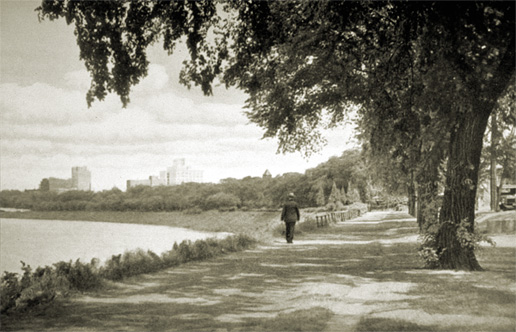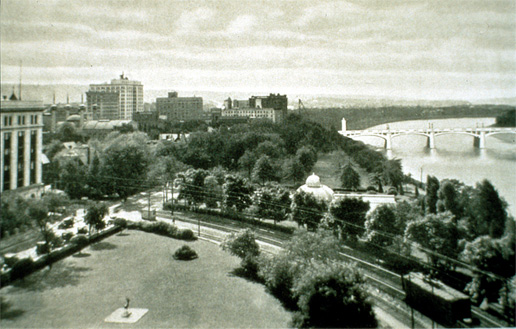 History of the Parks
History of the Parks
History of the Riverfront
The early inhabitants of the Wyoming Valley always took pride in the Susquehanna River and the land adjacent to it. Numerous Native American settlements were discovered along the river which was the Great Warriors Trail, a transportation route that stretched from New York State to North Carolina. It followed the western side of the Susquehanna in the area now known as Kirby and Nesbitt Parks.
In 1769, Wilkes-Barre’s first colonial settlers from Connecticut established the River Common on the east side of the river where they tethered their livestock. During the Revolutionary War, General George Washington sent 3,500 soldiers and 2,000 horses under General John Sullivan’s command to Wilkes-Barre in the summer of 1779. Sullivan’s headquarters were located just south of what is now the Market Street Bridge and the soldiers camped throughout the River Common. From their base in Wilkes-Barre, the Americans successfully fought the Iroquois and Tories in New York State.

In 1804, Wilkes-Barre’s park system was formally established and the River Common and center square were certified as parks. Each spring, many thousands of fish, mostly shad, weighing between two and eight pounds, swam up river to spawn. This event became an annual festival with feasts, parties, and drying fish occupying the River Common. The annual shad run in the Susquehanna was short-lived, as a dam was constructed at Nanticoke in 1830, blocking their spring run up river.
Philanthropy Saves the Riverfront
When anthracite turned Wilkes-Barre into a bustling, sprawling metropolis, people needed space to relax and play. The Wilkes-Barre Park Commission, established in 1906, encouraged citizens to donate land for parks and playgrounds. In May 1907, Abram Nesbitt, a civic minded self-made millionaire who amassed his fortune in the coal, railroad and streetcar industries, acquired 10 riverfront acres called “Rutter’s Grove” from the Erie Railroad Company, which he then donated to the City of Wilkes-Barre. Two months later, the L.D. Shoemaker Estate added 8 1/2 acres to the parcel. Together, they became Riverside Park, renamed Nesbitt Park in 1922. Today, this natural and historic greenway extends between the Veteran’s Memorial and Market Street Bridges.

In 1921, Fred Morgan Kirby, the five-and-ten-cent store magnate and the park’s namesake, donated over 70 acres of riverfront land on the west bank and hired the Olmsted Brothers firm, the preeminent landscape architects, to design a people’s park. Work on the park began in July 1921 before the plan was completed, and F.M. Kirby Park was officially dedicated on June 4, 1924. Though smaller than many parks designed by the Olmsted’s, Kirby Park resembled an English landscape containing clusters of flowering shrubs and ornamental trees; winding footpaths and a driveway with parallel bridle path; tennis courts and an athletic field with race track; a reflecting pool and caretaker’s cottage; and a bandstand and gazebo with views of the river. In 1932, the city added a zoo, featuring a monkey house, bear pits and animal cages. Several of these remnant structures can be seen in today’s Kirby Natural Area.
What is an Olmsted Park?
The Olmsted’s were a pioneering family of landscape architects. In the 19th century Frederick Law Olmsted, Sr. helped introduce the informal English garden style into North American public parks. His beliefs influenced his son and protégé, Frederick Law Olmsted, Jr., who designed Kirby Park for Wilkes-Barre philanthropist Fred Morgan Kirby.
Upon the retirement of their father in 1898, Frederick Law Olmsted, Jr. and brother John C. Olmsted joined the practice in Brookline, Massachusetts, forming the firm of “Olmsted Brothers.” For nearly 100 years (1857-1950) members of the Olmsted family were the nation’s preeminent park planners, designing more than 3,000 landscapes. Their work included New York City’s Central Park and Maine’s Acadia National Park; the park systems of Boston, Baltimore, Seattle, Buffalo, Rochester, Louisville and Chicago’s South Park; and the park of Wilkes-Barre’s River Common. John C. Olmsted died shortly before the Kirby Park project was commissioned in 1921.
Birth of the Kirby Natural Area
Following the devastating flood of 1936, the US Army Corps of Engineers built a 15-mile-long levee system along the Susquehanna River. This levee system divided Kirby Park in two, allowing nature to reclaim the floodplain side. Meadows gave way to a forest of tall canopy trees through a process called ecological succession. Over the past 60 years, periodic flooding has shaped the soils and plant and animal communities of this area. With each flood, (sometimes an annual spring event), new soils and leaf litter are deposited, creating a rich growing medium for species adapted to this unique environment. As you walk along the Olmsted Trail through the Kirby Natural Area you will experience a variety of habitats in this dynamic ecosystem that are constantly affected by the flowing river.
Studies and observations following the 1993 flooding along the Mississippi River illustrated that forest vegetation helped to protect existing levees by slowing water flow and reducing flood scouring effects that erode and break levees.
 Recent News
Recent News
New Date for Riverfest 2023 Announced
Riverfest 2023 is now August 12th and 13th! Join us for a day of food, entertainment, and activities in Nesbitt Park at Riverfest! Live Music, Children’s Scavenger Hunt,...
July 2023 »Volunteers Needed for Riverfest 2023 – August 12 and 13!
Volunteers Needed! Volunteer with us on August 12th and/or 13th at Riverfest! Help is needed with set up, parking, and more. All volunteers will receive a free T-shirt....
July 2023 »RIVERFEST POSTPONED!
Due to forecasted storms this weekend (all three days), including lightning, heavy rain, and wind, in the interest of public safety, the Riverfront Parks Committee is cancelling RiverFest....
June 2023 »








